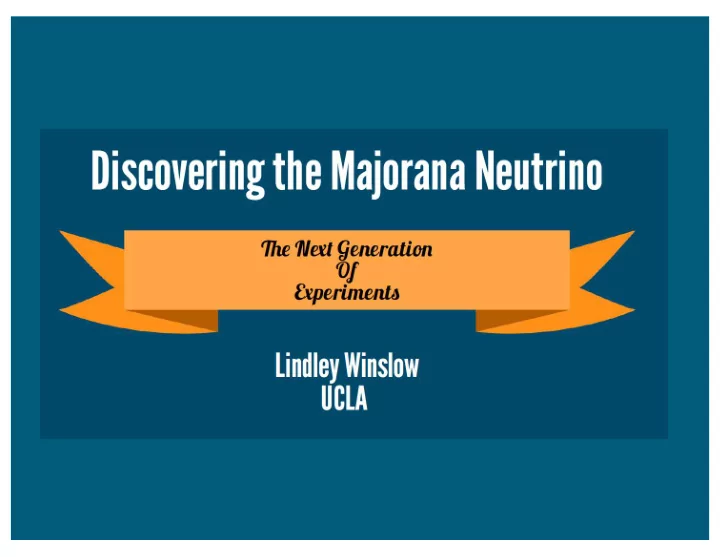

First Attempts at Te-Loaded Scintillator (at BNL) Conventional Loading Method (carboxylate-based organometallic complex) • … then, breakthrough new approach was developed at BNL, works for loading Te in liquid scintillator
Percent Loading of Tellurium is Feasible • 0.3%, 0.5%, 1%, 3%, 5% (from left to right) • 3% Te in SNO+ Phase II DBD corresponds to 8 tonnes of 130 Te isotope (cost for this much tellurium is only ~$15M)
Status • electronics and DAQ upgrades completed • now filling the SNO+ detector with water • water-filled data taking starts in 2014 • to study external backgrounds and detector optics • now installing liquid scintillator purification plant • liquid scintillator fill to start in 2015 • installation of tellurium purification skid and Te purification ☛ in late 2015 • addition of Te to SNO+ liquid scintillator and DBD run in 2016
Spectrum Plot (5-yr Simulated) 20 Counts/5 y/20 keV bin ν β β 0 (200 meV) nat 0.3% Te loading 18 ν β β 2 16 8 ν B ES 14 α γ 2.22 MeV ( , n) U Chain 12 Th Chain 10 External 8 6 4 2 0 2.2 2.3 2.4 2.5 2.6 2.7 2.8 Energy (MeV)
Also working on an imaging camera...
Tagging efficiency > 90%
The Trackers SuperNEMO and DCBA
Accurate(measurement(of( ββ (2 ν ) observables((NEMO3(results)( 7kg( 4(years( 700(000(events( S/B=76( ! Nuclear(physics(( ββ (2 ν ) half<life(to(extract(N.M.E.,(HSD(vs(SSD)( ! To(look(for(exoEc(physics(like(bosonic(neutrinos( F.(Piquemal( SuperNEMO,(NSAC(NLDBD(SubcommiLee(
F.#Piquemal# SuperNEMO,#NSAC#NLDBD#Subcommi<ee#
Calorimeter& Source& ! Ultra&low&background&detector& ! Modular&detector&with&3&main&components&:& " Central&source&foil&frame&&:&7&kg&of&isotope& " Tracking&:&2&000&dri?&chambers& " &Calorimeter&:&&712&scinAllators+&PMTs&& ! Shielded&by&iron&(300&tons)&and&water& ! ConstrucAon&in&progress& ! InstallaAon&and&commissioning&at&Modane& Underground&Laboratory&2014&–&2015& tracker& ! Data&taking&end&2015& No#background#expected#for#2#years#of#data.##7#kg# 82 Se###T 1/2# >#6.6#10 24 #y###<m ν >#<#0.16#–#0.44#eV##
That is all of them! Exciting R&D Ahead!
The above hope to get through the inverted hierarchy.
Dream Big!
We really need another signal! How about tracking?
Neutrinoless Double Beta Decay (Cherenkov Only)
The Cherenkov light is still there... Number of Cherenkov Photons for a 1MeV e- absorbed by scintillator Retains directional information!
Longer wavelengths travel faster and scintillation processes have inherent time constants.
arXiv:1307.5813 So if you have good enough timing.... PEs per event/0.1 ns 50 40 30 20 10 0 30 35 40 45 50 Time [ns] you should be able to separate the scarce Cherenkov from the abundant scintillation light.
If we put this timing data into basic reconstruction algorithms (from WCsim)... we can reconstruct vertices and direction at the center of the detector. arXiv:1307.5813
The separation needs more red light.
What about a more red sensitive PMT? � ���������������������� ��� ����������������� ������������������������������� ������������������������������� ��� ��� �� � ��� ��� � ��� ��� ��� ��� ��� ��� ��� ��� ��� ���������������
This gives beautiful results! PEs per event/0.1 ns 60 50 40 30 20 10 0 30 35 40 45 50 Time [ns] R c/s = 1.01 The problem is it is a 1cm diameter PMT... arXiv:1307.5813
����� ������ ������������������������������ ������������������������������������������ ����������������������� What if I could narrow the emission spectrum? � ��� �������������������������� �������������������������������������������� ��� ������������������������������ ��������������� ��� �� � �� �� �� � ��� ��� ��� ��� ��� ��� ���������������
This is the narrowed emission spectrum with traditional PMTs and 0.1ns timing. PEs per event/0.1 ns 60 50 40 30 20 10 0 30 35 40 45 50 Time [ns] R c/s = 0.86 This is the quantum-dot- doped liquid scintillator.
What are Quantum Dots? Quantum Dots are semiconducting nanocrystals. A shell of organic molecules is used to suspend them in an organic solvent (toluene) or water. Common materials are CdS, CdSe, CdTe...
Quantum Dot Materials Overlap with Candidate Isotopes! Isotope Endpoint Abundance 48 Ca 4.271 MeV 0.187% 150 Nd 3.367 MeV 5.6% 96 Zr 3.350 MeV 2.8% 100 Mo 3.034 MeV 9.6% 82 Se 2.995 MeV 9.2% 116 Cd 2.802 MeV 7.5% 130 Te 2.533 MeV 34.5% 136 Xe 2.479 MeV 8.9% 76 Ge 2.039 MeV 7.8% 128 Te 0.868 MeV 31.7%
Recommend
More recommend